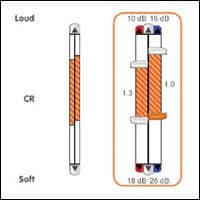Researchers evaluate the feasibility of Galaxy Buds2 Pro as a hearing enhancement device.
Inside the Research | April 2023 Hearing Review
By Ga-Young Kim, PhD, Han-gil Moon, PhD, Jaeseong Lee, PhD, and Il Joon Moon, MD, PhD
Last year, the U.S. Food and Drug Administration (FDA) issued a final rule allowing over-the-counter sale of hearing aids to promote hearing loss management.1 It is expected that various types of hearing enhancement devices, such as hearables, will consequently be released, including by smartphone manufacturers as an accessibility feature.

Samsung has provided a number of hearing enhancement features in their smartphones to help people with hearing loss. The adapt sound feature includes the ability to find the appropriate sound based on users’ age range or create their own personalized sound for their level of hearing impairment. The ambient sound feature increases the volume of ambient noise so users have a similar experience to traditional hearing aids (Figure 1).
In this article, we evaluate the feasibility of Galaxy Buds2 Pro with ambient sound as a hearing enhancement device in patients with mild-to-moderate hearing loss.
Methods
Participants
Twenty participants were included in this study. Inclusion criteria were: 1) age between 18 and 70 years, and 2) hearing threshold between 26 dB and 55 dB (mild-to-moderate HL) based on four-frequency averages (0.5, 1, 2, and 4 kHz) in both ears. The median age was 63.5 years. Among the 20 participants, four (20%) were males and 16 (80%) were females. The median pure-tone average was 36.88 dB HL for the right ear and 38.13 dB HL for the left ear (Table 1). The Institutional Review Board of Samsung Medical Center in Seoul approved this study (IRB No. SMC 2022-04-094).
Outcome measures
We performed standard hearing aid verification measures2 to determine how Galaxy Buds2 Pro with ambient sound benefitted patients with mild-to-moderate hearing loss.
1. Sound-field Audiometry
Unaided and aided sound-filed audiometry thresholds were obtained to examine functional gain. Functional gain is determined by comparing aided and unaided behavioral thresholds (unaided threshold—aided threshold). Frequency modulation tones of 0.25 to 8 kHz were presented through a loudspeaker located 1 m from 0° azimuth. Participants responded by pressing a button each time they heard the tone.
2. Sound-field Word Recognition Score (WRS)
Unaided and aided sound-field WRS were obtained to confirm how much the ability of speech discrimination was improved when hearing devices were used. Twenty-five monosyllabic words3 at 50 dB HL were presented through a loudspeaker 1 m from 0° azimuth. The participants were asked to repeat the word back to the tester. Percentage-correct scores were calculated.
3. Sentence Recognition in Noise
The Korean Standard Sentence Lists for Adults (KS-SL-A) was utilized to assess speech recognition in noise. The KS-SL-A consisted of eight lists of 10 sentences and 40 words each. After the participant was seated in the middle of the five speakers, sentences were presented at 50 dBA from the front speaker, while four-talker babble noise was presented from speakers at 45°, 135°, 225°, and 315°. The participants were asked to repeat the sentence back to the tester. Percentage-correct scores were calculated.

Procedure
Galaxy Buds2 Pro (Model No. SM-R510) paired with a Galaxy S9 (SM-G960N) running Android version 10 were used for this study. Galaxy Buds2 Pro were worn bilaterally. After wearing Galaxy Buds2 Pro, ambient sound was turned on and the volume was set to level 3 (maximum). Each clinical measure was performed twice in the unaided and aided conditions.
Statistical analysis
Using descriptive statistical analysis, median and interquartile range were presented for continuous variables while numbers and percentages were presented for categorical variables. The Wilcoxon signed rank test was used for pair-wise comparison between two conditions. All statistical analyses were completed using SPSS ver.25.0 (IBM Corp, NY, USA).


Results
1. Sound-field Audiometry
There were significant differences between the two conditions at 250 (p=0.018), 500 (p=0.048), 1000 (p<0.001), 2000 (p<0.001), 4000 (p<0.001), 6000 (p=0.002), and 8000 (p=0.004) Hz. The aided condition was more amplified than the unaided condition in all frequencies except for the 250 Hz (Figure 3).
2. Sound-field WRS
The aided condition (median=90%) yielded a higher score than the unaided condition (median=68%) (p<0.001) (Figure 4).
3. Sentence Recognition in Noise
There were no significant differences between the two conditions on the sentence recognition in noise test (p=0.954) (Figure 5).

Summary
The results suggest that the ambient sound feature of Galaxy Buds2 Pro has the potential to help people with mild-to-moderate hearing loss. The ambient sound feature is useful for watching TV at home or having conversations in a quiet place. However, unlike traditional hearing aids, the ambient sound feature did not help much in a noisy environment, possibly because both the target sound and noise were amplified to the same level. Despite these limitations, the ambient sound feature can serve as a budget-friendly option for those with mild-to-moderate hearing loss. This feature will be available in the near future.
Citation for this article: Kim GY, Moon HG, Lee J, et al. Samsung earbuds show promise as a hearing enhancement device. The Hearing Review. 2023;30(4):28-29.
References:






